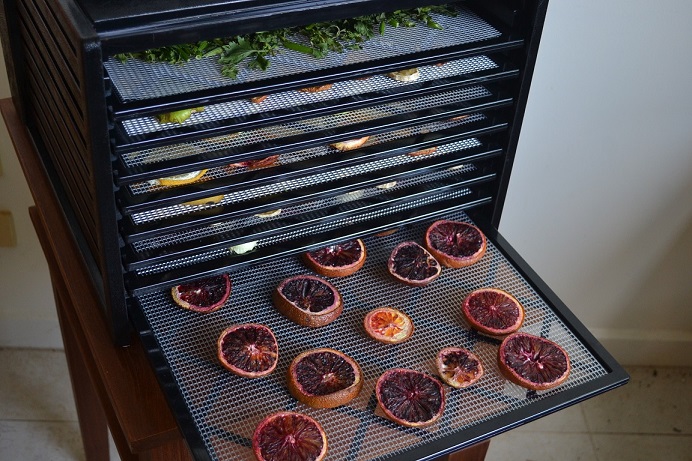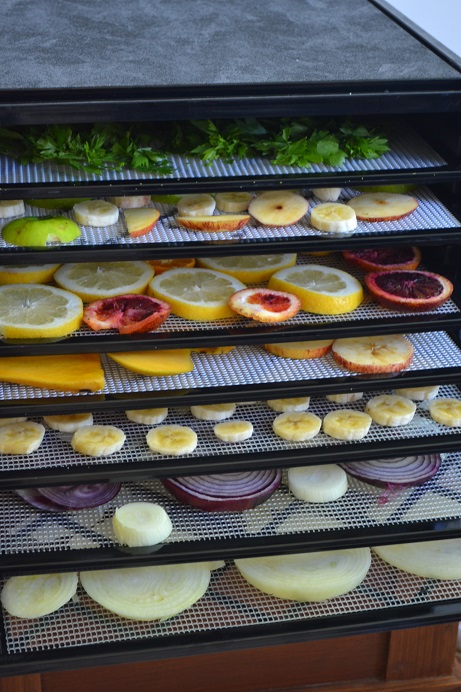If you’d come by our house recently, you might have thought Christmas had come again, because there was a lot of excitement over a large box. The moment it was dropped on our doorstep, we cut and pried at the package, hands getting in each other’s way as we tried to open it. Yes, our Excalibur dehydrator had finally arrived! This one piece of equipment has been on our wishlist for a very long time. You can find out more details about our dehydrator and support us at the same time here.
What is dehydrating?
Dehydrating is a simple and low-intervention way to preserve food. The basic idea is that if you remove enough moisture from food, then the growth of any mould, yeast and bacteria is stopped. Moist bread can grow mould within a few days, but have you ever noticed how long it can last if it dries out first? Well, the same basic idea is at work here.
It’s possible to dry foods out by leaving them under the sun, and this is still a viable method, but this way there’s no worry about bugs finding their way onto your food, and no rain or clouds to spoil your plans. You also couldn’t attempt outdoor dehydrating in cold wet winters. An oven can also be used, but much more care is required to ensure you get the times and temperatures right, and that you don’t overbake your raw ingredients and lose valuable nutrients.
A dehydrator is for the most part a set and forget affair. It uses a small amount of energy to house your food and circulate warm air over it for some length of time — usually several hours or more — until the food is dry and ready. If you have solar panels you can run your dehydrator for free. We run our dehydrator overnight to take advantage of off peak electricity rates, thus minimising any costs.
Choosing a dehydrator
We believe in investing in quality — buying one quality item that lasts is going to be infinitely more rewarding and better for the environment than having a multitude of cheap ones break on you. And for an appliance that you’re going to use again and again, like a dehydrator, it’s even more vital. Plus it’s important to ensure that your dehydrator doesn’t have any BPAs or nasty chemicals that could leak out during the long dehydrating process.
After comparing every dehydrator on the market and carefully reading reviews, we decided that the Excalibur dehydrator was the only one we could trust. Made in the USA with a long history of safety and reliability. It’s got a sturdy metal exterior, so it’s built to last. Its fan is also located at the back so that air is circulated evenly over all the levels, unlike cheaper dehydrators where the fan is located at the top or bottom and everything dries unevenly.

We chose the 9-tray over the 4 and 5 tray incarnations as we expect to do a lot of dehydrating in the future to preserve the abundant harvests of our Foodforest. Once it’s taken up space on your bench it’s a no brainer to go all out and opt for a high-rise. Also, it’s a lot more energy efficient to pump out 9 trays of goodness when you’ve already got the fan running.
Benefits of dehydrating
Dehydrating is one of our favourite ways to preserve, because of how just how low-fuss a process it is. And the end result, is compact and can be neatly stored away into bags or glass jars, taking up only a fraction of the space of what you started with.
- Unlike freezing — which needs an ongoing source of power to make sure it stays viable, and who else’s freezer is crammed to the brink with food & produce already?! — dried food can be stashed away in the pantry until you’re ready to use it.
- Unlike bottling or canning, you don’t need to be fastidious about keeping your tools clean and in getting your times and temperatures right. While we do bottle some of our home-grown produce, it’s not our preferred way to preserve – it requires specialised equipment, is a bit more fiddly (burnt fingers and hot equipment to juggle), and there’s always the lingering thought: Did I do it right or have I just bottled botulism?
- Unlike pickling or fermenting, dehydrated food doesn’t need to be stored in bulky liquid. Obviously you’ll want keep liquid right away from it!
Another awesome thing about dehydrating is that you can preserve pretty much anything — all sorts of fruit and veg, herbs, meats, dairy products, you name it. With a little bit of upfront planning, you can even puree your fruits, spread them onto a tray and create fruit leather. Yep — just like roll-ups! Because the temperatures involved in dehydrating are relatively low, much more nutrition in your food is retained, which is a big plus!
First impressions
For our first go at dehydrating, we tried a bunch of different ingredients to get a feel for the timing, and learnt how to get the best results. I would definitely err on the side of cutting things as thin as possible. I sliced my onions into rings of roughly half an inch thick, but next time I would go smaller — diced into fine cubes and spread evenly over the tray. Likewise, fruits and vegetables can benefit from being sliced as thinly as possible. The more space you can give your foods, the better too, as this allows space for warm air to circulate.
What to look out for?
In general, most fruits will still be leathery and flexible but you want to make sure your that foods are dry to the touch when done and are not obviously wet. Foods that you want to turn into powder, like celery and onion should be dryer than that and they should crumble in your hand.
Follow the times and temperatures in your manual, and be aware that times will vary based on how thick or thin you’ve cut your food, as well as how humid the climate in your house is. Also, if you’re drying different foods at the same time, try to make sure they have a similar drying temperature. Because things move so slowly, it’s easy to check in on your foods during the day and remove individual trays if they’re already finished.
| Food | Time | Temperature |
|---|---|---|
| Orange | 7 – 15 hrs | 57°C |
| Celery | 3 – 10 hrs | 52°C |
| Onion | 4 – 8 hrs | 52°C |
| Apple | 7 – 15 hrs | 57°C |
| Banana | 6 – 10 hrs | 57°C |
Even if your food seems done, it’s best practice to pop it into a jar and watch for signs of moisture in the days that follow. If you do notice some condensation, you can pop the food back into the dehydrator for a short amount of time to finish it off. It’s also a good idea to hold on to those desiccant sachets you get with packaged food. Chuck one of those in with your food in a tightly-sealed jar, and you’ll avoid having things go chewy over time.

First Impressions
My first impression of dehydration — apart from how fun it is! — is that it’s relatively foolproof (unlike canning, which sometimes feels like it needs a bit of faith). So long as you start with fresh, good-quality produce and make sure everything is well-dried, then you’re guaranteed to succeed. Things may take a little more or less time than the manual states, but there’s very little stress since the whole process operates over hours, and you have plenty of time to assess how things are tracking.
If you lack any sort of temperature control in your house (my hand is up), then a dehydrator is also apparently a decent solution for making yogurt and proofing bread. Given there’s a massive fan going, I’m inclined to think it’s overkill, but it might worth a try on those freezing winter days. We do bake a lot of bread, so I may give it a go next winter.
But, at the moment, I’m most looking forward to lots of abundant harvests from our fruit trees. Our fig tree hangs with the promise of lots of fruit, and once that comes to fruition (literally) we can transform our produce into dried figs, which will be great for kids’ lunches and snacks on-the-go. Equally exciting is the promise of using all of our dried fruit in bread, granola and other baked goods.
Stay tuned to hear more about dehydrating. This is just the beginning!